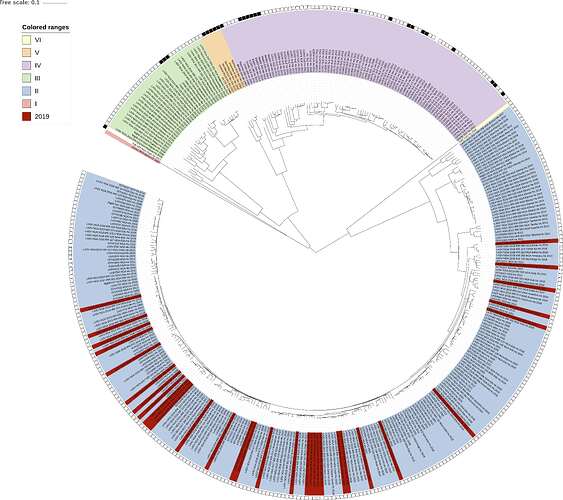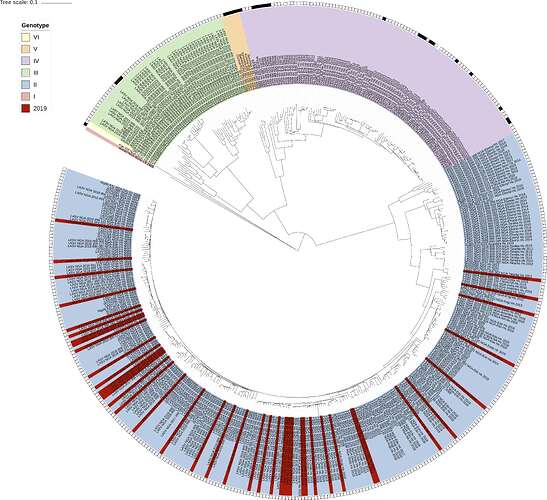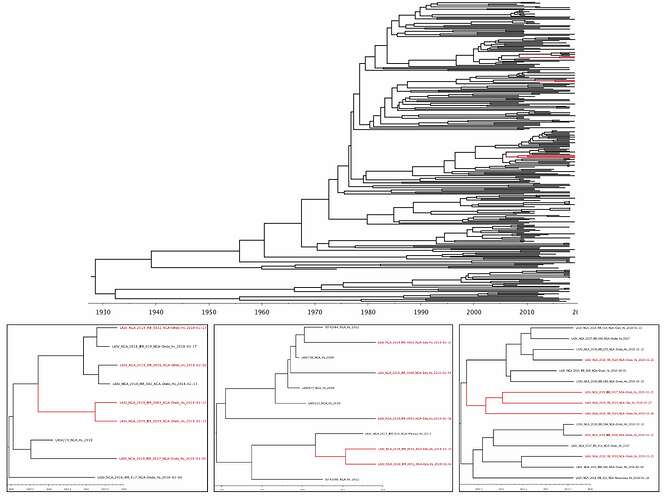Following up on our initial release of 19 sequences from our response to the Nigeria 2019 Lassa fever outbreak, we here present a second batch of 23 additional sequences (10 of which contain only the S segment), in a collaboration between the Irrua Specialist Teaching Hospital (ISTH), Institute for Lassa Fever Research and Control (ILFRC), Irrua, Edo State, Nigeria; the Bernhard-Nocht Institute for Tropical Medicine (BNITM), Hamburg, Germany; the Rega Institute / KU Leuven, Leuven, Belgium; the ARTIC network; and Public Health England (PHE), Salisbury, United Kingdom.
This brings the total to 42 sequences from laboratory-confirmed Lassa fever patients from the Edo, Ondo and Kogi States, with dates of onset ranging from end December 2018 to mid-February 2019. In order to obtain these sequences, MinION technology (Oxford Nanopore) is being used in conjunction with a non-targeted metagenomic RNA sequencing approach, which facilitates detection and sequencing of known pathogens including new lineages or clades of known pathogens as well as unknown pathogens. We refer to Kafetzopoulou et al. for more information (1).
We here make available sequence data from an additional 23 laboratory-confirmed Lassa fever patients, with sampling dates ranging from January 4th 2019 until February 19th 2019 (additional sequences are in the pipeline). Please note this is an early release with preliminary data (see also disclaimer below). Their consensus sequences for both the L and S segments can be downloaded here:
https://github.com/ISTH-BNITM-KUL-PHE/LASVsequencing2019
We again performed maximum-likelihood phylogenetic analysis of the coding genes in both the L and S segments, across all LASV lineages (I-VI), including those of 2018 and earlier years published by Kafetzopoulou et al. in Science in early January 2019 (1). Each of the new sequences was placed with the genotype II lineage, in both the L and S segments analyses (Figures 1 and 2, respectively). Thus, all 42 viruses transmitted in 2019 originate from the pool of lineages, sub-lineages and strains known to circulate in Nigeria. These results are in line with observations made during the 2018 Lassa fever outbreak.
In both L and S segment analyses, two clusters of 2019 viruses were observed (cluster 1: LASV-NGA-2019-IRR-0017, LASV-NGA-2019-IRR-0023 & LASV-NGA-2019-IRR-0024; cluster 2: LASV-NGA-2019-IRR-0051 & LASV-NGA-2019-IRR-0055). The S segments analyses produced an additional cluster of the LASV-NGA-2019-IRR-0003 & LASV-NGA-2019-IRR-0039 sequences (for the latter sequence, no L segment is available). In order to estimate the time of most recent common ancestors (tMRCAs) across the tree, we have generated a time-measured maximum clade credibility tree using BEAST on the genotype II lineage of the S segment data (Figure 3). The same clusters were recovered in both the maximum likelihood and Bayesian analyses. The aforementioned clusters have tMRCAs in March 2008 (95% HPD: 2004-2012) and April 2015 (95% HPD: 2013-2018), whereas the additional S segment cluster has a tMRCA in February 2016 (95% HPD: 2014-2018). Other divergence time estimates are similar to those of Kafetzopoulou et al. (1). This preliminary analysis hence shows infection events with different viruses that are not directly linked. This is consistent with spillover of viruses from the rodent reservoir to humans rather than extensive human-to-human transmission.
Figure 1: Lassa virus L-segment maximum-likelihood phylogeny. The circular tree includes all LASV lineages (I-VI) represented by different colour ranges. The squares at the tips represent host: empty square = human virus; black square = rodent virus; no square = laboratory virus. Newly sequenced segments generated in 2019 (32 in total so far) are depicted in red. All newly sequenced samples reside within the genotype II clade.
Figure 2: Lassa virus S-segment maximum-likelihood phylogeny. The circular tree includes all LASV lineages (I-VI) represented by different colour ranges. The squares at the tips represent host: empty square = human virus; black square = rodent virus; no square = laboratory virus. Newly sequenced segments generated in 2019 (42 in total so far) are depicted in red. As with the L-segment phylogeny, all newly sequenced samples reside within the genotype II clade.
Figure 3: Lassa virus S-segment time-measured phylogeny, focusing on the genotype II lineage. Newly sequenced viruses are depicted in red. Three clades containing 2019 Lassa virus sequences are shown in more detail: (0003,0039); (0051,0055); and ((0017,0024),0023).
Platform for sharing of sequences
The unpublished sequences are shared via the website virological.org (github link) under the following conditions: The Irrua Specialist Teaching Hospital (ISTH), Edo State, Nigeria; Bernhard Nocht Institute for Tropical Medicine (BNITM), Hamburg, Germany; Rega Institute, KU Leuven, Leuven, Belgium; the ARTIC network; and Public Health England (PHE), UK, are committed to sharing data in public health emergencies. We release unpublished Lassa virus sequences from Nigeria to support the public health response as well as the development and evaluation of Lassa fever diagnostics or therapeutics. The data may be used and analyzed for these purposes. It is however not permitted to use the sequences for publication. If you intend to so prior to our publication, please contact us directly:
Dr. Ephraim Ogbaini <[email protected]>, Director of Institute of Lassa Fever Research and Control,
Prof. Stephan Günther <[email protected]>, Director, WHO Collaborating Centre for Arboviruses and Hemorrhagic Fever Reference and Research, BNITM
(1) L. E. Kafetzopoulou, S. T. Pullan, P. Lemey, M. A. Suchard, D. U. Ehichioya, M. Pahlmann, A. Thielebein, J. Hinzmann, L. Oestereich, D. M. Wozniak, K. Efthymiadis, D. Schachten, F. Koenig, J. Matjeschk, S. Lorenzen, S. Lumley, Y. Ighodalo, D. I. Adomeh, T. Olokor, E. Omomoh, R. Omiunu, J. Agbukor, B. Ebo, J. Aiyepada, P. Ebhodaghe, B. Osiemi, S. Ehikhametalor, P. Akhilomen, M. Airende, R. Esumeh, E. Muoebonam, R. Giwa, A. Ekanem, G. Igenegbale, G. Odigie, G. Okonofua, R. Enigbe, J. Oyakhilome, E. O. Yerumoh, I. Odia, C. Aire, M. Okonofua, R. Atafo, E. Tobin, D. Asogun, N. Akpede, P. O. Okokhere, M. O. Rafiu, K. O. Iraoyah, C. O. Iruolagbe, P. Akhideno, C. Erameh, G. Akpede, E. Isibor, D. Naidoo, R. Hewson, J. A. Hiscox, R. Vipond, M. W. Carroll, C. Ihekweazu, P. Formenty, S. Okogbenin, E. Ogbaini-Emovon, S. Günther, S. Duraffour; Metagenomic sequencing at the epicenter of the Nigeria 2018 Lassa fever outbreak; Science 04 Jan 2019: 74-77; DOI: 10.1126/science.aau9343


